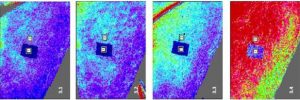The Effect of Calf Neuromuscular Electrical Stimulation and Intermittent Pneumatic Compression on Thigh Microcirculation.
Study Description: Neuromuscular electrical stimulation (NMES) devices and intermittent pneumatic compression (IPC) devices have been shown to be effective in improving blood flow. They are often used post-surgery to prevent deep vein thrombosis (DVT) in procedures such as total hip replacement and have been found to reduce oedema in the thigh of total hip replacement patients post-surgery.
Objective: This study compares the effectiveness of a neuromuscular electrical stimulation (NMES) device and an intermittent pneumatic compression (IPC) device on enhancing microcirculatory blood flow in the thigh of healthy individuals, when stimulation is carried out peripherally at the calf.
Results: Both NMES and IPC devices increased blood flow in the thigh when stimulation was carried out peripherally at the calf. The NMES device increased mean blood perfusion from baseline by 399.8% at the VMA state and 150.6% at the NVMA state, IPC device increased the mean blood perfusion by 117.3% from baseline. The NMES device at VMA state increased microcirculation by more than a factor of 3 in contrast to the IPC device. Even at the NVMA state, the NMES device increased blood flow by 23% more than the IPC device. Given the association between increased microcirculation and reduced oedema, NMES may be a more effective modality than IPC at reducing oedema, therefore further research is needed to explore this.
Publications:
The effect of calf neuromuscular electrical stimulation and intermittent pneumatic compression on thigh microcirculation – ScienceDirect Bahadori S, Immins T, Wainwright TW. The effect of calf neuromuscular electrical stimulation and intermittent pneumatic compression and intermittent pneumatic compression on thigh microcirculation. Microvascular Research. 2017;111:37-41.doi:10.1016/j.mvr.2017.01.001.
A Novel Approach to Overcome Movement Artifact When Using a Laser Speckle Contrast Imaging System for Alternating Speeds of Blood Microcirculation (video) | JoVE Bahadori S, Immins T, Wainwright TW. A novel approach to overcome movement artifact when using a laser speckle contrast imaging system for alternating speeds of blood microcirculation. JoVE Journal Medicine. doi:10.3791/56415-v.



